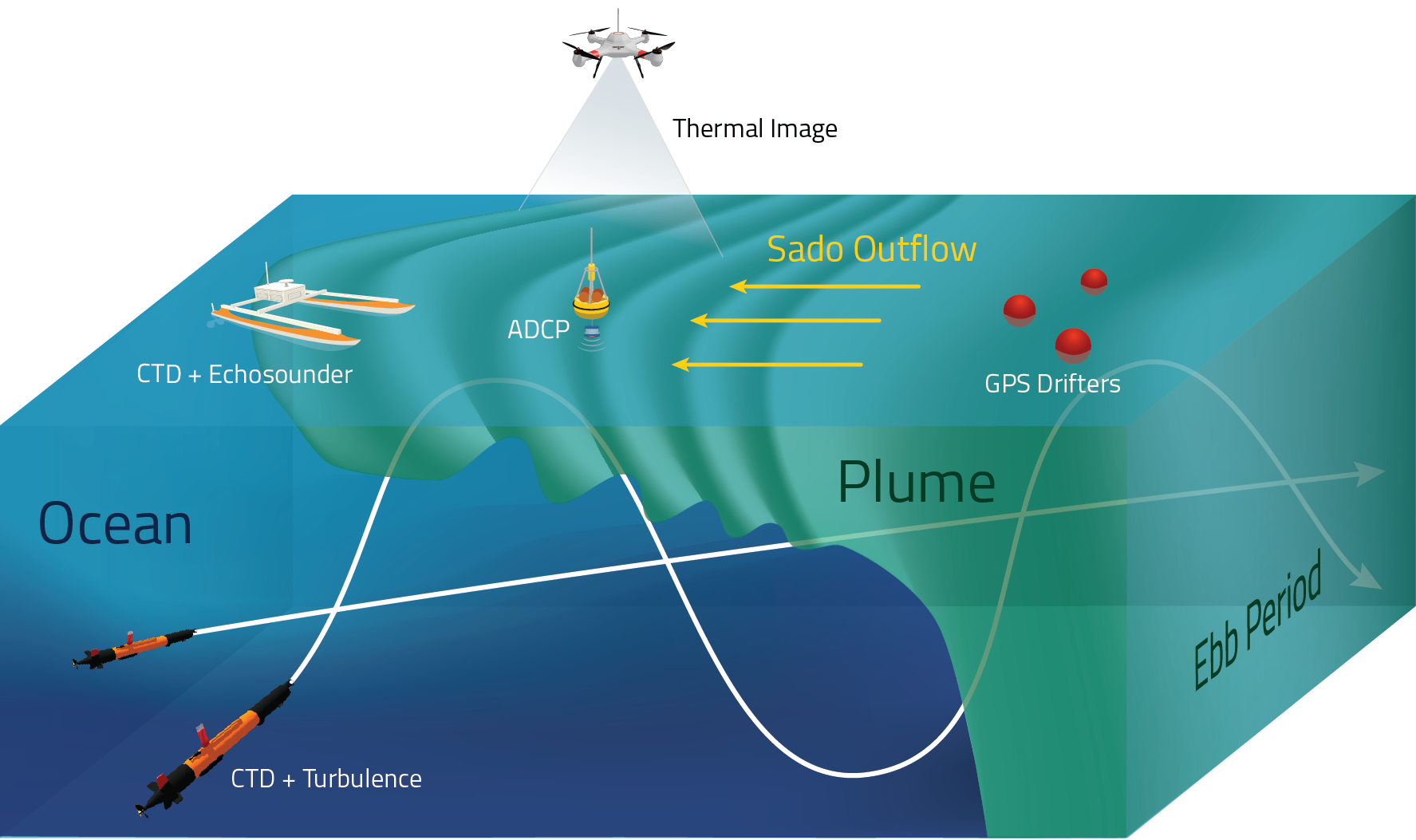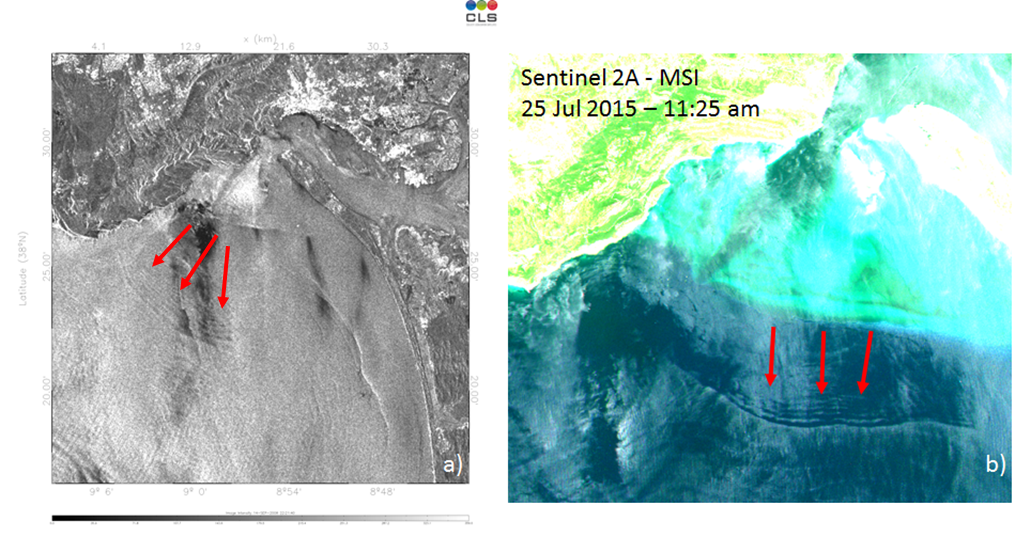SNoW - Sado Nonlinear Internal waves
On the generation of nonlinear internal waves in the Sado Estuary ROI
Scenario Overview
This scenario will take place south east from Portinho da Arrabida and will encompass multiple system deployment, seen on the map, to maximize quality data collection. It centers on unique observations of nonlinear internal solitary waves in the region of influence of the Sado Estuarine outflow using new and emergent oceanographic instrumentation.

Internal solitary waves (ISWs), generated by strong nonlinearity where internal waves can develop into sharp solitons wherein the thermocline dramatically shoals tens or hundreds of meters in only a few minutes, appear to be a key contributor because of turbulence they produce when they propagate and/or break (St. Laurent et al., 2011). These ISWs play an important role in transferring heat, energy, and momentum in the ocean and the turbulence they produce when they break is now recognized as a vital aspect of the ocean's meridional overturning circulation. Because numerical circulation models cannot simultaneously resolve climate and internal wave scales, IW breaking must be parameterized in these models. The magnitude and distribution of IW-driven mixing is then of critical importance to ocean models, and hence a major motivation for the study of oceanic internal waves.
In this scenario high-resolution observations will be performed to study the front vertical and surface structure, including measurements of velocity, salinity, water temperature, turbulence, turbidity and optical backscatter throughout the water column, using a synergetic network between LAUVs, Wavy’s, UAVs, and remote sensing platforms.
Moreover, utilizing the latest technology available installed onboard LAUVs (OMST), we intend to measure shear microstructure and coincident density structure from which we derive the dissipation rate of turbulent kinetic energy (ε) (Palmer et al., 2015). These measurements will be the first attempt to characterize the turbulence properties in the study region and one of the first turbulence direct observations taken from an internally recording microstructure instrument mounted to an autonomous platform, such a LAUV.

Scenario Detailed View
As seen in the map the scenario will take place southeast of the main navigation channel in a region quite far from coast which will present some logistically and technologically difficulties . A closer look at Figure 3 allows the analysis of bathymetric details of the proposed operation area.
The survey scenario consists on the collection of hydrographic data (CTD) and micro-turbulence measures (MicroRider) using a LAUV (OMST) during the course of an ebb period (about 6 hours) along a perpendicular transect to the propagation of the estuarine front (see map). Simultaneously with the LAUV (OMST) an ASV (Caravela) with an EchoSounder and CTD will be deploy along the same transect. While CTD data will provide a more accurate position of the front at the surface layer, the EchoSounder data will contribute to identify the propagation and/or generation of solitons in the thermocline interface. The LAUV (OMST) and ASV (Caravela) deployment will be at the furthest offshore position of the transect, moving from the ocean to the river’s mouth until reaching shallower Sado’s region. As seen in Figure 1 the scenario will also incorporate GPS Surface Drifters (Wavy) and UAV (X2O-01) flights with camera payload. The GPS Surface Drifter (Wavy) system will complement the overall understanding of the IW progression by providing information from the Sado’s surface velocity on the shallower section of the operation area. The ADCP and EchoBox, placed at about the half-point of the SaVel transect, will also contribute with profile velocity and vertical structure data. Those fixed-point sensor will provide a valuable data from ocean circulation behaviour prior and posterior to the short-time SNoW operation.
The UAV (X2O-01) will allow tracking the wave’s front progression, through the use of thermal imaging payload, up to the point where the bathymetry has a steep drop. This is one of the endpoints for the LAUV’s (OMST) transect.
Although planned transect will not cross any important vessel transit lane, this survey represents a impressive challenge in terms of temporal schedule. There will be a very low probability to observe and measure the propagation and generation of any soliton in the Sado’s region. Thus, several constraints will be taken into account in this operation to increase the probability of observing internal waves, maximizing the amount and variety of data to a proper characterization:
- Operation must be carried out during an ebb tidal period (about 6-7 hours) when thermal stratification is likely to be boosted by warmer water from estuary and surface current is sufficiently high to generate a soliton.
- Satellite data represents huge advantage to a better understanding of the internal waves generation trigger in this coastal region. So, operation must be planned to coincide with several satellite overpassing. In this case, Terra SAR-X and Sentinel 2A are our best attempt considering their spatial resolution and radiometric characteristics. Therefore, July 14 and 20 turn out to be the key operation days target (Figure 3).
- Ebb period starts after high tide peak at 7:00 am in July 14, with Aqua, Terra and Sentinel 2A overpasse around low-tide peak (12:54 pm).
- On July 20 Terra SAR-X overpasses Sado’s region during the afternoon’s end (7:23 pm) coinciding with low-tide peak (7:24 pm), while ebb starts after high-tide’s peak (1:09 pm).
Note that there is always a lag between surface elevation and tidal-driven currents. Depending on tidal cycle, ebb (flood) period starts about 1-3 hours after high (low) tide peak.



